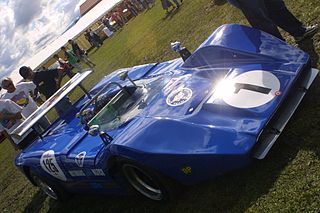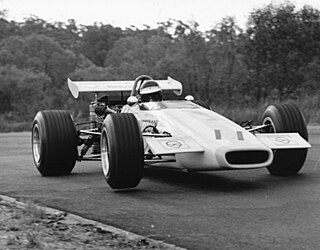
Australian Formula 2, sometimes abbreviated to AF2 or ANF2, is a "wings and slicks" formula racing category in Australia. The category is one of Australia's oldest, dating back to 1964. The current format of AF2 was introduced in 1978. Brian Shead of Cheetah Racing Cars and Garrie Cooper of Elfin Racing Cars were largely responsible for the development of the format, which was devised to suit the needs of Australian drivers, most of whom had little or no sponsorship and had to bear the costs of racing out of their own pockets.
The 2007 Australian Drivers' Championship was a motor racing title for drivers of Formula 3 racing cars, with the winner awarded the 2007 CAMS Gold Star. The title, which was the 51st Australian Drivers' Championship, was awarded to the winner of the 2007 Australian Formula 3 Championship. The championship, which began on 4 February 2007 and finished on 4 November at Oran Park, consisted of 16 races at 8 rounds across 4 different states.
Australian Formula 3 has been the name applied to two distinctly different motor racing categories, separated by over twenty years.
The 1964 Australian Drivers' Championship was open to drivers of Racing Cars complying with either the Australian National Formula or with the Australian 1½ Litre Formula. The title was contested over a five-round series.
The 1982 Australian Formula 2 Championship was a CAMS sanctioned Australian motor racing title open to cars complying with Australian Formula 2. The title, which was the 15th Australian Formula 2 Championship, was won by Lucio Cesario driving a Ralt RT3 Volkswagen.

Australian Formula 1 (AF1) was a motor sport category for open-wheeler racing cars which was current in Australia from 1970 to 1983.

The Australian National Formula was an Australian motor racing category which was introduced by the Confederation of Australian Motor Sport in 1964 and remained current until the end of 1969. It had replaced Formula Libre as the Australian premier racing formula.
The 1973 Australian Drivers' Championship was a CAMS sanctioned national motor racing title open to drivers of Australian Formula 1 and Australian Formula 2 cars. It was the seventeenth Australian Drivers' Championship and the championship winner was awarded the 1973 CAMS "Gold Star".
The 1990 Australian Drivers' Championship was an Australian motor racing title sanctioned by the Confederation of Australian Motor Sport and open to Formula Holden racing cars. It was the 34th Australian Drivers' Championship and the second to be contested by Formula Holden cars. The championship winner was awarded the CAMS Gold Star.

Group A Sports Cars is an Australian motor racing category that CAMS formulated for sports car racing in Australia. Introduced in 1964, it continues today under the name Group 2A Sports Cars.
The 1966 Australian Drivers' Championship was a CAMS sanctioned motor racing title for drivers of racing cars complying with either the Australian National Formula or the Australian 1½ Litre Formula. The winner of the title, which was the tenth Australian Drivers' Championship, was awarded the 1966 CAMS Gold Star.
The 1968 Australian One and a Half Litre Championship was a CAMS sanctioned motor racing title for drivers of Australian 1½ Litre Formula racing cars. It was the fifth and final Australian One and a Half Litre Championship to be awarded prior to the demise of the formula at the end of 1968.
The 1970 Australian Drivers' Championship was a CAMS sanctioned motor racing title for drivers of Australian Formula 1 and Australian Formula 2 racing cars. The winner of the title, which was the fourteenth Australian Drivers' Championship, was awarded the 1970 CAMS Gold Star.

The 1971 Australian Formula 2 Championship was a CAMS sanctioned motor racing title for drivers of Australian Formula 2 racing cars. It was the fifth Australian Formula 2 Championship.
The 1957 Australian Drivers' Championship was a CAMS-sanctioned Australian motor racing title for drivers of Formula Libre cars. The championship was contested over a nine race series with the winner awarded the 1957 CAMS Gold Star. It was the first Australian Drivers' Championship and the first motor racing title to be decided over a series of races at Australian circuits.
The 1967 Australian Drivers' Championship was a CAMS sanctioned Australian motor racing title for drivers of cars conforming to Australian National Formula or Australian 1½ Litre Formula regulations. The winner of the championship was awarded the 1967 CAMS Gold Star. It was the 11th Australian Drivers' Championship to be awarded by CAMS.
The 1969 Australian Drivers' Championship was a CAMS sanctioned Australian motor racing title for drivers of cars conforming to Australian National Formula or Australian Formula 2 regulations. The championship was contested over a six race series with the winner awarded the 1969 CAMS Gold Star. It was the thirteenth Australian Drivers' Championship to be awarded by CAMS.
The 1971 Australian Drivers’ Championship was a CAMS sanctioned motor racing title open to Australian Formula 1 and Australian Formula 2 racing cars. It was the fifteenth Australian Drivers' Championship and the first to feature cars complying with a new for 1971 Australian Formula 1 which permitted cars with production based V8 engines of up to 5 litre capacity or racing engines of up to eight cylinders and up to 2 litre capacity. The championship winner was awarded the 1971 CAMS Gold Star and the title of Australian Champion Driver.
The 1972 Australian Drivers' Championship was a CAMS sanctioned Australian motor racing title open to Australian Formula 1 and Australian Formula 2 racing cars. It was the 16th Australian Drivers' Championship to be awarded by CAMS. The championship winner, Frank Matich, was awarded the 1972 CAMS Gold Star.
The 1967 Australian One and a Half Litre Championship was a CAMS sanctioned Australian motor racing title for racing cars complying with the Australian 1½ Litre Formula. The title, which was the fourth Australian One and a Half Litre Championship, was won by Max Stewart, driving a Rennmax BN1 Ford.






